


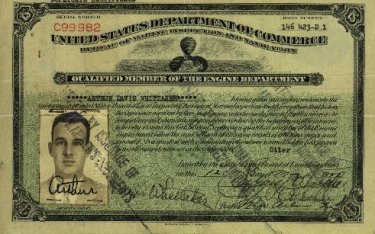
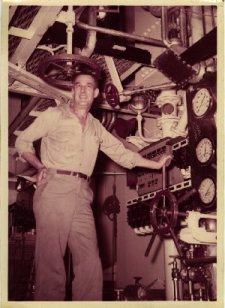
My father, Arthur Whittaker, had quite an interesting career at sea even before I was born. Because he had learned to splice four strand line, he found a job as an Ordinary Seaman in the steamer R. Lenahan on the Chesapeake Bay in 1934. Soon he had become Quartermaster and Able Seaman in the steamers Eastern Shore and Dorothy Bradford. Finally in 1939, after a few years onboard as Quartermaster, he sailed as a Fireman in the excursion steamer S.S. Potomac, and continued with her until the summer of 1940. At that point, he hired onto a Standard Oil tanker of the Panama Transport Company, S.S. Geo. H. Jones, as a Fireman, and moved up to Oiler for his second voyage with her. Jones was an old ship built in 1919 by Sun Shipbuilding in Chester, PA. She was only about 6,900 tons gross, 10,500 tons deadweight. She had a single screw and a triple expansion steam reciprocating engine. By March of 1941, he had become the ship’s Machinist, and he remained so until he left the ship 29 August 1941 when it was turned over to the British under the Lend-Lease Act. It would not survive another year. It was torpedoed and sunk on 11 June 1942.
On 10 November of 1941, he had been hired as Machinist into another Panama Transport Company ship, M.V. Esso Bolivar, a motor tanker. Bolivar was a larger ship, about 10,700 tons gross and 15,200 tons deadweight. She had large 8 cylinder diesel engines. During a voyage from Aruba to Bayonne, NJ in December, he heard rumors on the radio that war was imminent, and finally that war had been declared on Japan. On Monday, 8 December 1941 he heard about the attack on Pearl Harbor and that war had been declared on Japan at 12:40 EST. The next day, he notes in his diary, the Panamanian flag was removed and no longer flown. After pulling into Bayonne that Friday, the ship was painted completely grey by a tiger team of about 50 men in one day. He only made one more voyage in Esso Bolivar, a voyage rudely interrupted.
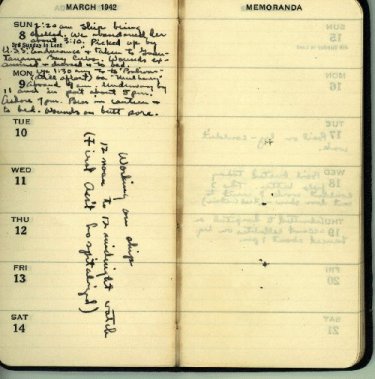
His diary does not note when he advanced to the grade of Third Assistant Engineer, but it does record that he signed back on Esso Bolivar as Third Assistant Engineer on 20 February 1942. His discharge slip for that voyage also indicates this, so now he had become an officer in the Engine Department. Apparently, he sailed as Third Assistant on a wartime waiver due to the need for officers during the hostilities. They left Bayonne on Saturday, 21 February bound for Aruba. They made a small detour into the Chesapeake Bay on 27 February for a test and inspection of their degaussing system, and to receive routing instructions from the Navy before proceeding. On 1 March, they left for Aruba. Since there were not convoys in those early days of the war, Esso Bolivar travelled alone. At about 2:20a.m. on Sunday, 8 March, he noted in his diary, the ship was being shelled by a German submarine. The ship was also torpedoed. They were approximately 30 miles southeast of Guantanamo Bay, Cuba, and the Master, Captain James M. Stewart, turned toward the Naval Station there in an attempt to get closer to support, while directing radio operator to send an SOS. An acknowledgement was received just before the radio was put out of action by a shellburst. My father was able to help one of the wounded, Ordinary Seaman Vaught, but to no avail. He was too seriously wounded, having had a shell explosion shatter his leg. He was bleeding badly, and died while the tourniquet was being applied to his leg.
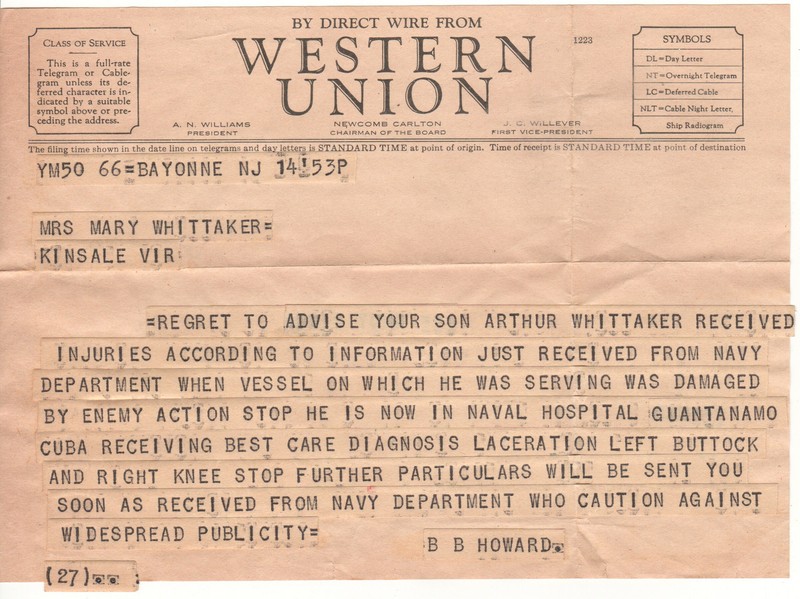
At some point, around 3:10a.m. according to his diary, the ship was ordered abandoned. He had been wounded, though not seriously, in the leg and buttock by shellfire, and was uncomfortable in the water. He was picked up by a lifeboat which had been launched, and stayed with it until they were picked up by the minesweeper, USS Endurance sometime in the morning. They were taken to Guantanamo Bay and treated for their wounds in the infirmary, and allowed to sleep. During the day, they agreed with the Chief Engineer, the senior surviving officer, that the ship could be saved. They were loaded onto the net tender Mulberry (AN-27) and returned to the ship around 9:00a.m on Monday, 9 March. By about 11:00a.m. they were underway on their own power, and pulled into Guantanamo Bay for temporary repairs. There they remained until 25 March, having I-beams welded across the hole left by the torpedo, but no shell plating. The ship left for Mobile on the 25th under it’s own power with a naval yacht for escort. They arrived around 10:00p.m. on 31 March.
He stayed with the ship for some of the repairs in Mobile, and got his seaman’s papers replaced, since they had been burned in the shelling of the ship. He was hired by Mr. William “Billy” Freeman of U. S. Salvage as a marine surveyor while he was there, and he left the ship on 21 April 1942. He worked with U. S. Salvage on the gulf coast for most of the rest of the war. He did not write much about it, and did not talk about it much, except that he had to investigate a case of sabotage once at Ingalls Shipbuilding in Pascagoula. His diary essentially ended in 1942, and there have been few records of his activities that I have yet procured, but he did quit U. S. Salvage sometime around the end of 1944, and he went back to sea again in January, 1945. He had now been hired by one of the most interesting and influential ship operators in the postwar business.
His next ship was a new one, and a big one for the time. S.S. Bulkero was built in 1944 by Welding Shipyards, Inc in Norfolk, VA for the company National Bulk Carriers, owned by Daniel K. Ludwig, a self made shipping baron. Ludwig, who had been busy in the shipping business for several years, was just beginning to amass his sizeable fortune by working with the Maritime Commission and War Shipping Administration to build tankers for war use which he would acquire for his own after the war. Bulkero was a T3 type tanker of a design only built by Welding Shipyard; about 11,000 tons gross, 18,900 tons deadweight. My father signed on as Third Assistant Engineer on 10 January 1945, and remained aboard her until 5 April 1946. He made a cruise to Japan on this ship after the end of the war. By August of 1945 he was sailing as Acting Second Assistant Engineer, and remained in that capacity until he left the ship. Following service on Bulkero, he took a little bit of time off to spend at home now that the war was over. He worked for his father-in-law-to-be in Virginia as a land surveyor for about a year.
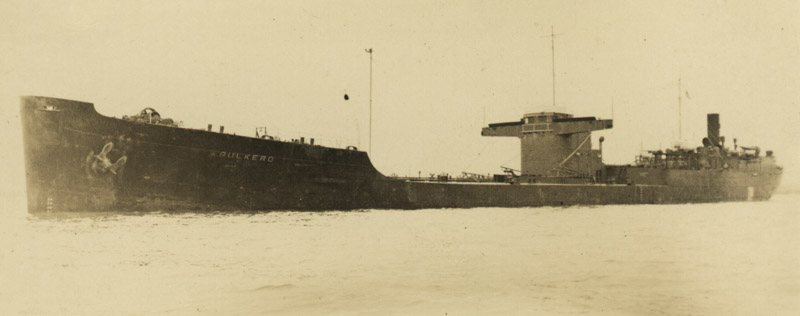
By April of 1947 he was ready to go back to sea again. He again signed onto a National Bulk Carriers ship as Second Assistant Engineer, Pan Massachusetts, another ship of the same size and design as Bulkero. He was only aboard her for about a month. The ship was in Texas City, TX on 18 May 1947 preparing to depart with a cargo of aviation gasoline when it caught fire at about 7:30a.m. The fuel burned so fiercely that he and several others were forced to jump overboard and swim under burning fuel to reach safety. The fire was extinguished that afternoon, but the ship, a tug and the pier were heavily damaged. This was less than a month after the notorious fire and explosion of the ship Grandcamp, which leveled part of the city and killed more than 600. Not wishing to experience another such explosion, many of the citizens were preparing to leave the city as Pan Massachusetts burned. He was paid off this ship on 29 May.
He remained with National Bulk Carriers for almost the rest of his seagoing days. His next ship was one of the largest of the day, the 23,800 deadweight ton S.S. Amtank, also built for National Bulk Carriers by Welding Shipyards, the company owned shipyard. He sailed as Second Assistant from 14 June 1947 to July 7 1947. Then he moved on to his first T-2 tanker, S.S. Little Big Horn and then to a sister of Bulkero, S.S. Bulklube for about 3 months. This is significant in that he sailed in T-2’s purchased by Ludwig and National Bulk Carriers for the next several years, working his way up from Second Assistant to Chief Engineer by 1950. Click here for as complete a list of Arthur Whittaker’s ships as I am able to come up with.

In 1950 he received his Chief Engineer’s license, and sailed on it for the first time as Chief in S.S. Kaposia, a T-2 built by Alabama Drydock and Shipbuilding Company in 1945. Ludwig had a program of re-configuring the engineering plants on these ships from turbo-electric propulsion to steam turbine propulsion using war surplus navy turbine sets. This ship was no exception. In 1948, Kaposia was outfitted with steam turbines for her propulsion. Although my father had sailed in steam turbine plants almost exclusively until 1947, he had no difficulty understanding electricity, and was quite adept at running the turbo-electric plants too. He sailed in both types of Ludwig T-2’s, seven in all, and in 1952 was assigned to S. S. Whittier Hills as Chief Engineer, a job he held until some time in 1955. For more information on T-2 Tankers and a listing of all T-2 Tankers built, click here.
Following his long tour as Whittier Hills‘ Chief Engineer, he made a few trips in S.S. Amtank, S.S. Bulkoil and S.S. Petroemperor as First Assistant, and was then assigned to S. S. Bulkpetrol in May 1955 as First Assistant. Bulkpetrol was the largest tanker afloat when she was built, but not for long as Ludwig had started a race with the Greeks when he launched her. She was launched in 1948 and was almost 630 feet long, 84 feet wide, and was rated at 15,591 tons gross, 30,011 tons deadweight. He sailed in Bulkpetrol for about a year, completing a “round the world” voyage and then sailed in Bulktrader, the last of the Bulkpetrol class ships, for a short voyage. In November 1956 he was assigned to Ore Regent as First Assistant and remained with her until May 1957. In June 1957, he was assigned to S.S. Phoenix as Chief Engineer. He served as her Chief Engineer for five years, doing some time also on Bulkpetrol as Chief Engineer on relief duty. Phoenix was another “largest ever” tanker when she was launched in 1953, 26,085 tons gross, 44,633 tons deadweight. She was built by Ludwig’s National Bulk Carriers, Kure Shipbuilding Division in the former Japanese naval shipyard leased by Ludwig. Ludwig had leased the yard in 1950 when the ships he was planning were too large to be built in his single berth Welding Shipyard in Norfolk. He built most of his ships there, and gradually replaced war surplus T-2’s with the behemoths built in his new yard in Japan. For an amazing list of ships built by Ludwig, click here.

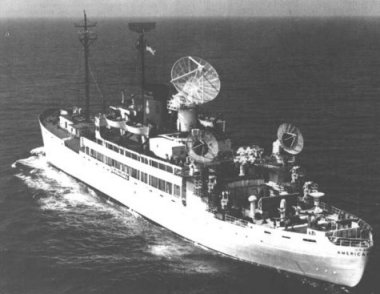
By 1963, my father was getting tired of some of the company policies which he said intruded on his prerogatives as Chief Engineer. He was in some hot water when he pulled into Amsterdam on Bulkpetrol as Chief Engineer in 1963 and had not allowed the Deck Department any water to washdown with since the boilers were in such bad shape that they used an excessive amount of water which the evaporators were hard pressed to keep up with. The port engineer and the company were pretty upset about that. In August of 1963, while assigned as Chief Engineer on relief duty in S.S. Ore Transport, a 60,000 deadweight ton twin screw ore ship, he decided he had had enough of the company’s policy changes, and quit. Although he quit as one of their shipboard engineers, they asked him to remain as one of their port engineers. He replied that he would be glad to, so long as he would be able to conduct business from an office in Virginia. The company stated that that wasn’t possible, and that he would have to work from New York City. He declined the offer. Eventually, he hired onto his last ship, a converted Liberty ship, S.S. American Mariner. American Mariner was converted while she was being built in Bethlehem-Fairfield shipyard to be a cadet training ship. Following that, she was converted again in the late 1950’s into a missile tracking ship for the Air Force, and was used by them at Cape Canaveral for tracking rockets and missiles. He sailed in her as Third Assistant Engineer, looking for a change from the life aboard the National Bulk Carriers’ tankers. While aboard her, he had a seizure, identified as ventricular tachycardia, very rapid beating of the heart. The cause was never determined. He quit going to sea. He had several more bouts with this peculiar malady in the next several years, gradually tapering off by 1975. In the 32 years which passed since his first spell until his death in June of 1997, no cause was ever found. Stress was presumed to be the cause, but was never positively identified.
After he quit going to sea, he settled down in Virginia on his wife’s farm and took up the profession of land surveying. He initially worked for an old retired U.S. Navy Seabee and family friend named Arthur Cooke. He worked for him for a few years until he obtained his own license and Surveyor’s stamp; then he went into business for himself. In the late 1970’s and early 80’s, times were tough for a small business such as he ran, and he again worked for another firm, owned by Lloyd English. After a few years, things got better, and Lloyd English went on to another job, and my father went back into business for himself. He surveyed land until after he reached the age of 80 in 1993. He was still active and able to get around in the woods, but had decided to retire when he had his second hip replacement surgery. (The first only held him up a few months.) In January of 1994, the family house in Virginia burned down, and with it went most of his old papers and old shipboard and seagoing photographs. Only one leather briefcase was rescued, accidentally. In it were his diaries from 1930 to 1942, some of his seaman’s papers and discharge slips up to 1954, some very old pictures, and a lot of old letters and small artifacts. I have attempted to distill what I know and what I have found out into this small tribute to one of our old salts, a Merchant Seaman during the post war shipping revolution.